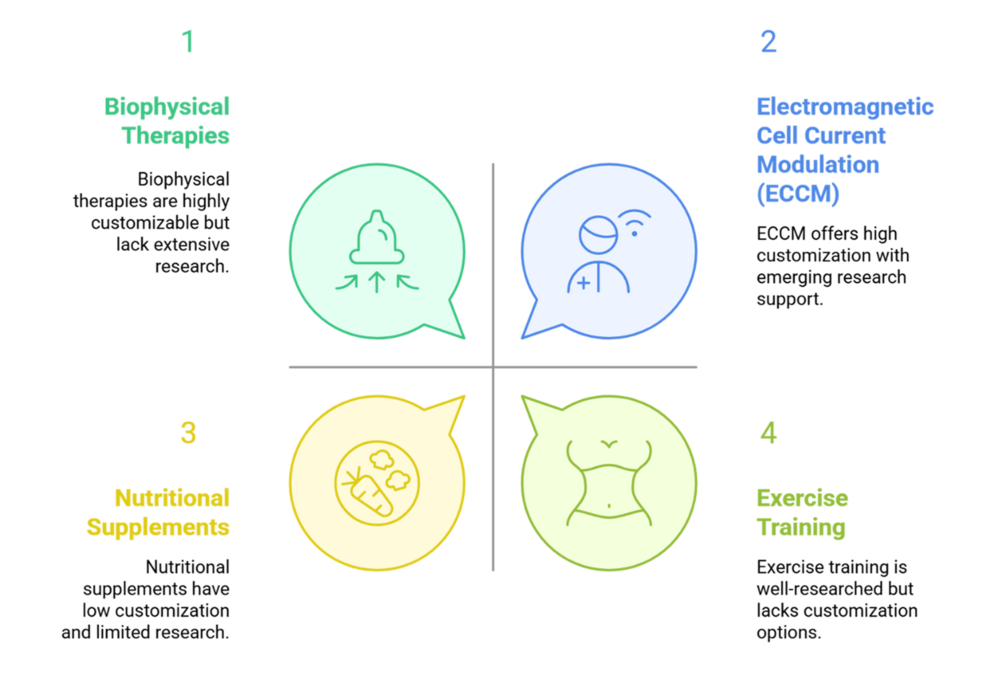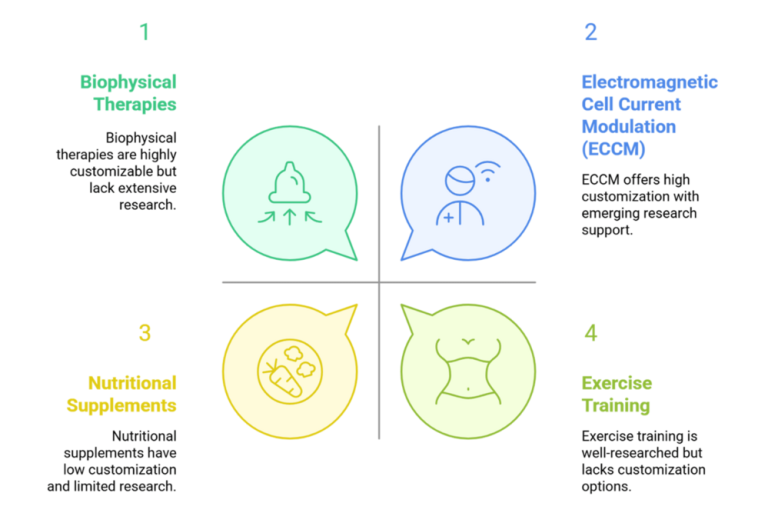
Exploring Electromagnetic Cell Current Modulation in HIV Therapy
The emerging use of electromagnetic cell current modulation (ECCM) as an adjunct therapy in HIV is an intriguing idea that has captured the attention of both clinicians and researchers. Although antiretroviral therapy (ART) remains the mainstay of HIV management, a growing number of studies point to the possible benefits of adding non-pharmacological interventions to address the tangled issues of chronic immune activation, mitochondrial dysfunction, and systemic inflammation in people living with HIV.
This editorial takes a closer look at ECCM as a potential supplementary treatment, discussing the promising early findings, the challenging parts of the research, and the key questions that lie ahead. We will also consider how this technique compares to other adjunct therapies available today and explore areas that are essential for future investigation.
Understanding ECCM: How It Works
Electromagnetic cell current modulation involves the application of low-intensity electromagnetic fields (EMFs) to cells, aiming to restore their electrical balance and enhance various cellular functions. The idea is that by carefully calibrating these non-ionizing fields, practitioners can influence calcium influx, mitochondrial ATP production, and cytokine signaling.
Many laboratory experiments suggest that specific EMF parameters can help reduce inflammation and oxidative stress—both of which are believed to play roles in the persistent symptoms experienced by many HIV patients even after successful viral suppression. The mechanism relies on adjusting the fine points of cell signaling and metabolic balance, an approach that, while promising, comes with its own set of confusing bits and delicate challenges.
Potential Benefits of ECCM as an Adjunct Therapy
Improved Immune Function and Reduced Inflammation
A growing body of evidence points to some beneficial effects of ECCM on immune cells. Researchers have observed that careful EMF exposure can help modulate cytokine production, reducing pro-inflammatory markers like TNF-α and IL-6 while enhancing anti-inflammatory cytokines. This is especially attractive in HIV management because chronic immune activation remains an unsolved issue even when viral replication is controlled.
Key aspects include:
- Stabilization of mitochondrial membrane potential, which may help preserve CD4+ T-cell counts.
- Potential regulation of immune cell apoptosis, thereby reducing cell death associated with chronic inflammation.
- Modulation of intracellular signaling pathways such as NF-κB and MAPK to temper immune hyperactivation.
These effects, if confirmed in larger well-controlled studies, could help mitigate the nerve-racking challenges of immune dysregulation while complementing the benefits provided by ART.
Enhancing Mitochondrial Function and Energy Production
One of the most promising aspects of ECCM is its alleged ability to support mitochondrial performance. In HIV patients, the damage to these cellular “powerhouses” is a central issue that contributes to fatigue, tissue injury, and reduced quality of life. By potentially boosting mitochondrial respiration and ATP production, ECCM could offer a dual benefit: reducing oxidative stress and promoting better cellular energy balance.
This approach could be especially important for patients who struggle with the off-putting side effects of long-term ART usage. The possibility of restoring energy metabolism addresses some of the small distinctions between mere viral suppression and achieving overall clinical improvement.
Comparing ECCM with Other Adjunctive Therapies
ECCM Versus Nutritional and Herbal Interventions
Over the years, nutritional supplementation and herbal therapies have been explored as complementary strategies in HIV management. While these options may help support overall health and immune function, they often suffer from issues related to absorption variability and inconsistent potency. In contrast, ECCM is a physical intervention that is noninvasive and reversible. The ability to precisely calibrate the electromagnetic fields offers a level of control that many supplemental or herbal therapies lack.
Below is a simplified comparison:
| Characteristic | Nutritional/Herbal Therapy | Electromagnetic Therapy (ECCM) |
|---|---|---|
| Mechanism | Biochemical modulation through ingestion | Physical modulation via electromagnetic fields |
| Customization | Limited by metabolic variability | High, with programmable frequency and intensity |
| Invasiveness | Noninvasive, but absorption can vary | Noninvasive and controlled application |
| Potential Side Effects | Drug-drug interactions possible | Minimal if properly calibrated |
While both strategies may be valuable, ECCM’s unique advantage lies in its reversibility and the possibility to adjust treatments based on individual patient symptoms.
ECCM in the Spectrum of Non-Pharmacological Interventions
Other non-pharmacological strategies in HIV care include mindfulness-based therapies, physical exercise regimens, and emerging techniques like low-level laser therapy. Each of these approaches comes with its own set of tricky parts and subtle differences.
Some key observations include:
- Mindfulness and exercise primarily address psychological and physical stress but may not influence cellular metabolism directly.
- Photobiomodulation therapies tend to work on a more localized level with limited tissue penetration.
- ECCM offers the potential to influence deep tissue functions, potentially making a meaningful difference in immune cell metabolism and overall inflammatory status.
This broader context underscores how ECCM may offer a super important complement to traditional and alternative therapies if its benefits are confirmed in rigorous clinical trials.
Preclinical and Clinical Evidence: The Good, the Bad, and the Uncertain
Early Laboratory Studies and Fine Points in Cellular Models
In vitro experiments have shown that EMFs can affect cells in a number of ways. Some studies report reduced expression of pro-inflammatory cytokines, even as others warn of potential increases in reactive oxygen species (ROS) under higher intensity exposures. These conflicting findings illustrate the tangled issues of determining optimal exposure parameters.
Key observations from laboratory studies include:
- Reduced inflammatory signaling in low-frequency exposures.
- Improvements in mitochondrial performance under selective conditions.
- Inconsistent data when exposure is not standardized, leading to variable outcomes.
It’s clear that more work is necessary to figure a path through the little details and optimize the use of EMF therapy in a way that brings out its best potential while avoiding unwanted side effects.
Animal Models: Insights and Limitations
Animal studies provide a bridge between cellular experiments and clinical practice, although direct evidence in applicable HIV models such as simian immunodeficiency virus (SIV) or humanized mice remains scarce. Most of the supportive animal data come from studies in other inflammatory or viral contexts, where EMF exposure has shown promise in reducing systemic inflammation and even influencing viral replication patterns.
However, there are several challenges in interpreting this evidence:
- Differences in immune system complexity between species.
- Variability in exposure durations and intensities used in different animal studies.
- Lack of standardized protocols limits the ability to replicate findings across laboratories.
These confusing bits highlight why translating animal study data to human HIV management requires careful and rigorous follow-up in targeted research models.
Small Pilot Clinical Studies: Promising Yet Preliminary
Early-stage clinical experiments and case series on ECCM in HIV patients have shown improvements in surrogate markers, such as modest increases in CD4+ T-cell counts and subjective reports of reduced fatigue and pain. Although encouraging, these studies suffer from nerve-racking limitations including:
- Very small sample sizes with limited statistical power.
- Inconsistent reporting of treatment parameters such as duration and intensity.
- Lack of control groups, which makes it hard to know if improvements are directly attributable to ECCM.
Thus, while the early findings provide a hint of possible clinical relevance, they fall short of delivering conclusive evidence. More robust randomized controlled trials are needed to confirm the benefits and eliminate the uncertainties that linger in the preliminary data.
ECCM and ART: Working Through the Integration Process
Synergy Between Electromagnetic Therapy and Antiretroviral Treatment
Antiretroviral therapy has given HIV patients a new lease on life by dramatically reducing viral loads and managing disease progression. Still, ART does not fully normalize immune function or address many of the metabolic issues that complicate HIV management. In this context, combining ART with ECCM could offer a more complete solution by addressing both viral suppression and the host’s lingering immune dysfunction.
A few potential synergy aspects include:
- Immune Activation Reduction: ECCM might help lower residual inflammatory markers that persist even during effective ART.
- Mitochondrial Support: By improving mitochondrial metabolism, ECCM could counteract some of the metabolic side effects associated with long-term ART use.
- Enhanced Recovery: The complementary effects may lead to better overall immune restoration and improved quality of life.
However, the integration of these therapies requires careful study, as there remains the possibility that electromagnetic fields might affect the pharmacokinetics of drugs. Continued research is necessary to ensure that ECCM can be safely and effectively paired with ART without compromising either treatment’s efficacy.
Table: Comparing ART and ECCM Interventions
| Aspect | ART | ECCM |
|---|---|---|
| Primary Goal | Suppress HIV replication | Modulate host immune function and improve cell energetics |
| Strengths | Extensive evidence base; proven reduction in viral load | Potential for reducing inflammation and oxidative stress; noninvasive |
| Limitations | Does not address persistent metabolic dysfunction or chronic inflammation | Preliminary data; needs standardization and further evaluation |
| Use in Combination | Standard treatment | Adjunct to support immune recovery and metabolic balance |
This table highlights the complementary roles of ART and ECCM and serves as a conceptual framework for future research aimed at combining both therapies for enhanced patient outcomes.
Safety and Ethical Considerations in ECCM Application
Addressing the Overwhelming Bits of Safety Concerns
One of the largest worries related to ECCM is its long-term safety profile. While studies in orthopedics and wound healing suggest that low-intensity EMFs are generally safe, using them on a systemic level in immunocompromised patients raises several important questions:
- Potential Genomic Effects: Even if electromagnetic fields are non-ionizing, there is ongoing debate about whether prolonged exposure might subtly affect DNA stability or interfere with repair mechanisms.
- Oxidative Stress Balance: The same EMF parameters that promote antioxidant defenses under some conditions might, if misapplied, enhance the production of harmful reactive oxygen species.
- Device Safety: There is also concern about interference with implanted devices such as pacemakers, particularly in aging patients who may require long-term adjunctive therapies.
These points illustrate why rigorous, long-term studies are an essential step before ECCM can be widely adopted in HIV care. Standardizing exposure levels and monitoring outcomes closely will be key to ensuring that the technique is both safe and effective.
Ethical Challenges and Transparent Communication
Introducing any new intervention to HIV care comes with ethical challenges. There is a delicate balance between exploring innovative therapies and ensuring that patients do not forgo life-saving ART in favor of unproven alternatives. The history of alternative therapies in HIV is riddled with instances where unproven methods misled patients, making it critical that developments in ECCM are communicated with complete transparency and rigorous scientific backing.
Key ethical considerations include:
- Ensuring that ECCM is promoted strictly as an adjunct therapy rather than a replacement for ART.
- Conducting fully informed consent processes for trial participants.
- Maintaining strong regulatory oversight and publishing full study data to build trust.
This open and cautious approach not only protects patients but also establishes a solid foundation for building credibility in the scientific community regarding ECCM.
The Future of ECCM in HIV Care: Challenges and Opportunities
Charting the Way Forward Through Rigorous Research
Before ECCM can be considered a mainstream adjunctive therapy, several nerve-racking research gaps need to be addressed. The journey ahead involves:
- Standardizing Protocols: Researchers must agree on definitive exposure parameters—frequency, field strength, waveform, session duration, and total dose—to enable reproducible studies.
- Expanding Preclinical Studies: Validated animal models, especially those tailored to HIV’s unique persistence and latency issues, are needed to evaluate both the efficacy and safety of ECCM.
- Conducting Large-Scale Clinical Trials: Well-designed randomized controlled trials with clear endpoints (e.g., changes in immune markers, patient-reported outcomes) are essential to move ECCM from preliminary studies to accepted therapy.
- Investigating Synergies with ART: Careful pharmacokinetic and pharmacodynamic studies should assess how ECCM might interact with widely used ART regimens, ensuring that the treatments complement rather than interfere with one another.
By also considering aspects like cost-effectiveness, scalability, and accessibility in resource-limited settings, future research can help shape ECCM into a super important tool in comprehensive HIV management.
Factors to Consider in Developing ECCM Protocols
Successful incorporation of ECCM into clinical practice will depend on several key factors:
- Customization: The ability to tailor electromagnetic exposure based on individual symptom profiles is a major advantage over more generic interventions.
- Safety Monitoring: Ongoing surveillance of both short-term and long-term adverse effects will be critical during broader clinical application.
- Standardization Across Studies: Cooperation between multiple research centers can help develop cohesive guidelines and reduce variability in study outcomes.
These considerations, while representing just a few of the many tricky parts inherent in ECCM research, are essential to building a robust evidence base and ensuring that the potential benefits are fully realized.
Conclusion: A Promising Adjunct with Caveats
As we take a closer look at ECCM as an adjunct therapy for HIV, we see a landscape filled with promising possibilities and a number of challenging twists and turns. The approach offers several advantages—ranging from the potential to modulate immune activation and enhance mitochondrial function, to the possibility of being precisely calibrated for individual patient needs. However, the current evidence base is still in its early stages, and the confusing bits of inconsistent study designs and preliminary data mean that ECCM should be viewed as an exciting possibility rather than a proven treatment.
The future of ECCM in HIV care will depend on rigorous, multi-disciplinary research that addresses both the biological mechanisms and the practical aspects of treatment integration. Most importantly, robust clinical trials are necessary to determine whether ECCM can become a key element of comprehensive HIV management alongside standard ART, nutritional support, and other adjunctive therapies.
In the meantime, the medical community must continue to exercise caution. While it is tempting to get into every new technique that promises improved quality of life for people living with HIV, it is essential to steer through the fine details and confirm that the method reliably produces measurable benefits without causing hidden problems over time.
For now, the idea of using electromagnetic cell current modulation as a supportive tool in HIV care remains an interesting and potentially valuable field of research. Patients and clinicians alike should stay informed about developments in this area while continuing to rely on well-established treatment protocols. The integration of innovative adjunct therapies like ECCM represents a promising frontier, one that combines the benefits of cutting-edge technology with a deep understanding of chronic disease management.
As future studies clarify the mechanisms, optimize the protocols, and establish clear clinical benefits, ECCM may well emerge as a super important complement to existing therapies—helping people living with HIV to manage not just the virus, but the many intertwined challenges that affect daily life. Until that time, the research community must continue to dig into the science and work through each challenging piece with a commitment to rigor, transparency, and patient safety.
Ultimately, the promise of ECCM signifies a broader trend in modern medicine where non-pharmacological interventions are being explored to support traditional therapies. This integrated approach could transform how we support the body’s own healing mechanisms, potentially reshaping treatment paradigms not only for HIV but for other chronic diseases as well. The road ahead may be full of complicated pieces, but with careful, coordinated research and open-minded clinical inquiry, electromagnetic therapy might one day play a role in reallocating the balance toward better health outcomes for all.
Originally Post From https://www.cureus.com/articles/410332-electromagnetic-cell-current-modulation-as-adjunctive-therapy-in-hiv-a-review
Read more about this topic at
Electromagnetic Cell Current Modulation As Adjunctive …
Pulsed electromagnetic field (PEMF) as an adjunct therapy …


